People
‘There Is No Sense of Privacy Anymore’: After Kim Gordon’s Personal Life Went Public, She Decided to Tackle Surveillance in Her Art
The former Sonic Youth bassist's new show is on view now at 303 Gallery in New York.
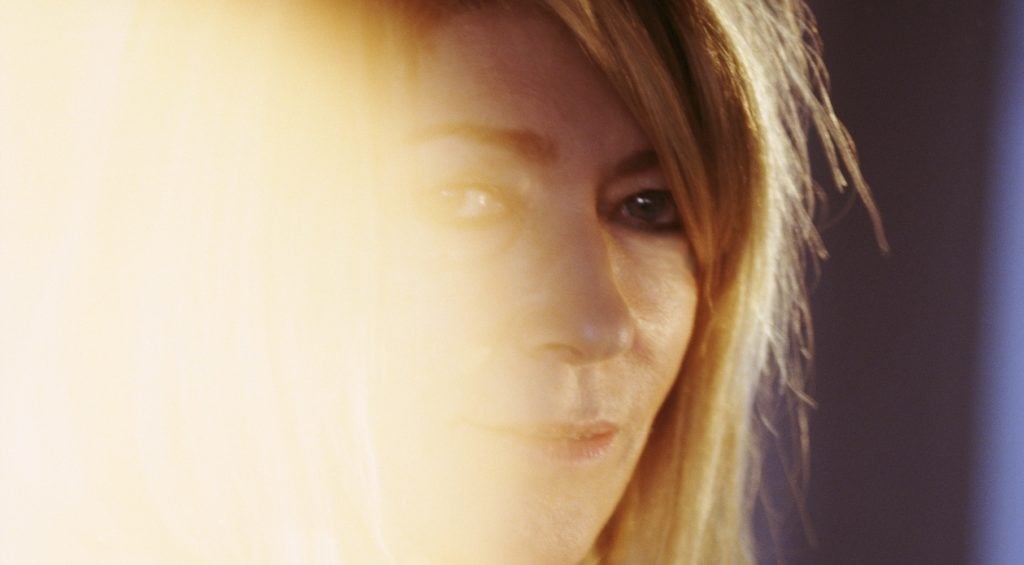
The former Sonic Youth bassist's new show is on view now at 303 Gallery in New York.

Taylor Dafoe

Before she was Sonic Youth’s iconic bassist, sing-speaking recondite poetry over squealing guitars, and before she published her memoir, started a fashion line, and acted in films, Kim Gordon was an art-school kid staging interventions in friends’ apartments. The goal, she wrote at the time, was to use “art to deconstruct design.”
40 years later, the impulses behind those interventions still inform Gordon’s art making. Following the rather public dissolution of her band and marriage in 2011, Gordon moved to her hometown of Los Angeles and refocused on her art practice, which enacts some of the same public-vs-private tension that’s ungirded her personal life over the past decade.
“It’s kind of ironic that I ended up as a public person who’s sort of uncomfortable with it all,” Gordon tells Artnet News over the phone from her home in California. She’s just returned from New York, where her show “The Bonfire” opened at 303 Gallery. She’s battling a rough head cold from the trip, but her voice is unmistakably familiar.
Lining 303’s walls are blurry, amber-tinted photographs of friends encircling a beachside bonfire. The scene is jovial, but the context is not. Subjects are framed by digitized rectangles—the type that pop up when facial recognition software hones in on a known pixel pattern; others have crosshairs trained on them, like the targets of a drone strike. It’s all a reminder that even the most intimate of moments are threatened by technocapitalism’s watching eye.
Meanwhile, a recent performance piece, Los Angeles June 6, 2019, blares from a stack of monitors in the center of the gallery. In it, Gordon uses LA’s municipal architecture—handrails, benches, cornices—to play a screeching guitar, reclaiming the space through a kind of earsplitting ritual that’s equal parts Vito Acconci and Glenn Branca.
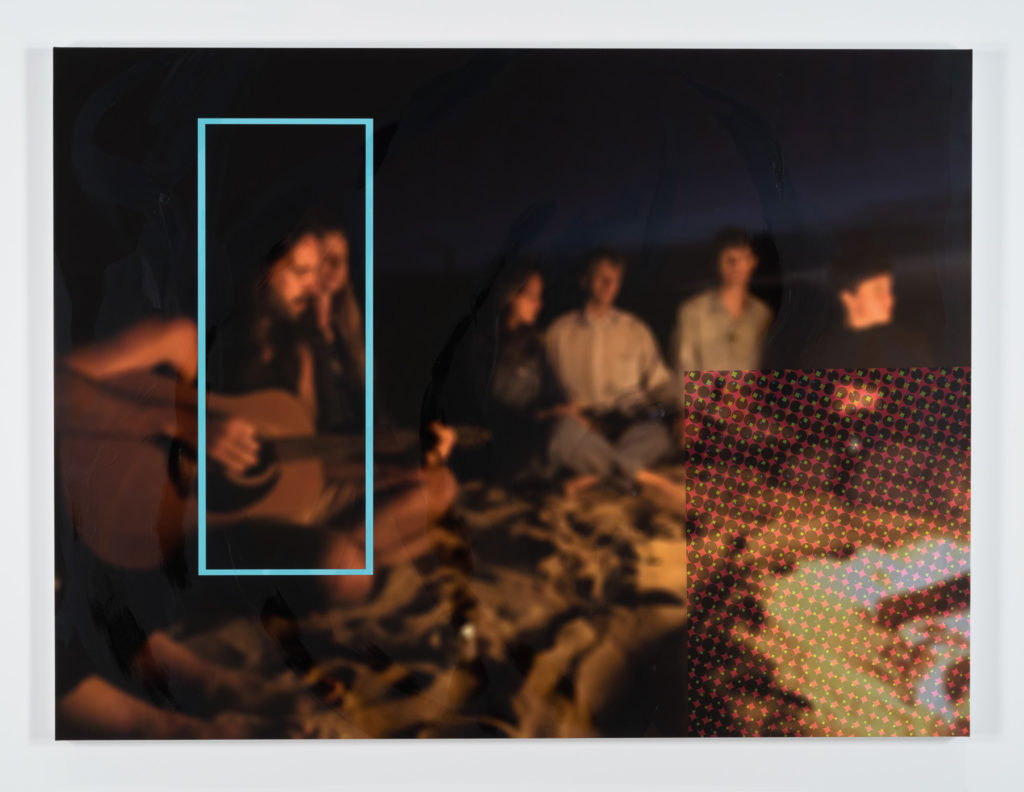
Kim Gordon, The Bonfire 7 (2019). © Kim Gordon. Courtesy 303 Gallery, New York.
Let’s start with the bonfire images. What is it about this scene that interested you?
It’s just an archetypal image. Last summer I was in Provincetown and my friend organized a bonfire. She had to get a license just to have it on the beach. I took those pictures as it was happening and I just thought they looked really cool. The lighting reminded me of Old Master paintings.
I had been thinking a lot about the branding of different experiences. For example, the way Airbnb now rents out things like camping trips, selling you on the idea that you’ll live like a cowboy. These are special private moments that are being highlighted and sold. In actuality, there is no sense of real privacy anymore. And people don’t care until it turns into something bad.
Atop the canvas prints are swathes of acrylic medium. They’re almost unnoticeable until the light hits them. What was the intention of using the acrylic on those works?
I wanted them to be more than just photographs. It’s almost like a shadow painting. Creating a secret painting in public is interesting to me. There are also overlaid, Photoshopped digital surveillance lines. They tie in with a video that Loretta Fahrenholz did for one of my songs, “Earthquake.” She had these special effects people use those graphics to hide people’s faces because we didn’t have release forms. I liked the idea of tying it in with that. I’ve always had my art and music so separate, but they’re starting to merge together more.
Those Photoshop graphics kind of create a hybrid design and an abstraction within a representational picture. You see that a lot in design—everything is designed to tie together. It’s all kind of like a modern-day landscape to me.
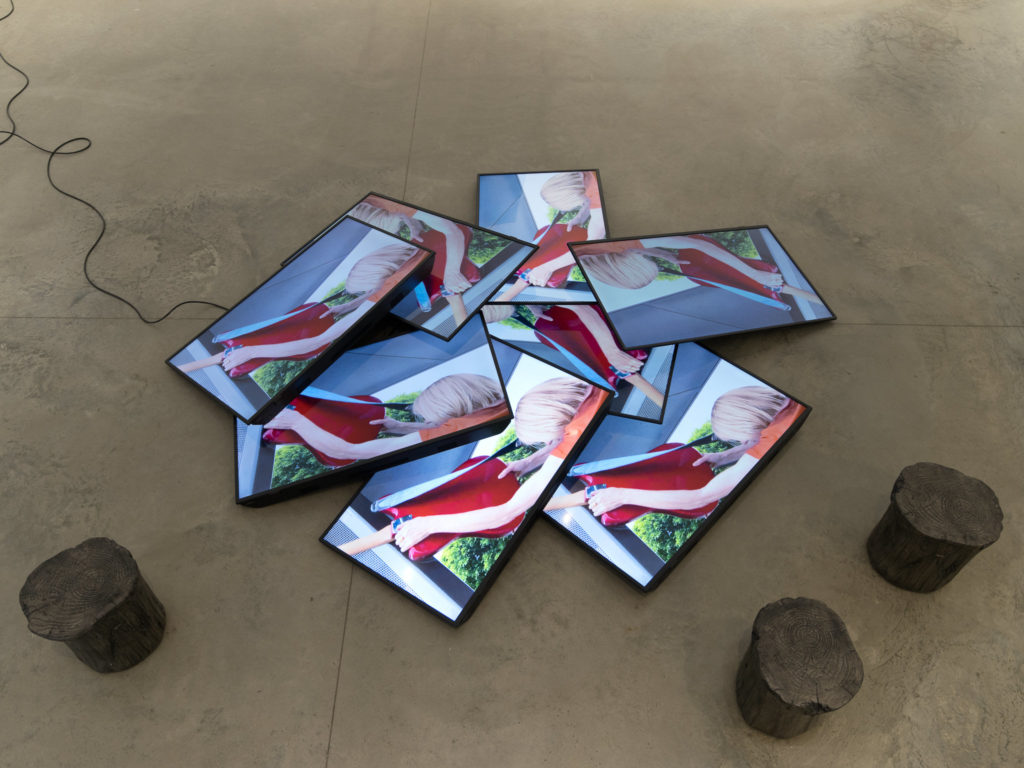
Kim Gordon, Los Angeles June 6, 2019 (2019). © Kim Gordon. Courtesy of 303 Gallery, New York.
There’s a great dialogue between the video installation and the bonfire prints. In the video, while you’re roving around LA with your guitar, the viewer becomes hyper-aware of all the security cameras in the background and the way that public and municipal space is being controlled and privatized.
And the security guards were everywhere. It was like I was a terrorist. Understandably, I guess—when you do something like that… [Laughs]
I’m interested in the gardens and the waterfalls and the way landscaping works in those corporate plazas throughout the city. It’s something I’m particularly aware of in LA—even more than New York—how those things disguise this corporatization of city life.
You conceived this work, Los Angeles June 6, 2019, as a one-off performance. How does its current form as a video installation change the piece for you?
I actually made it for this show that took place between Sète, France, and LA. It was an idea I’d had for a long time. I always liked the way the Dogtown skaters repurposed those corporate buildings, the stairways and the railings. I wanted to do the same thing, reclaim the space using those same railings as giant guitar slides. I asked a documentary filmmaker friend to shoot it and she did such a great job. She shot it with three iPhones. It was originally shown in a storefront on Sunset Boulevard, which was pretty cool because the sound of the traffic going by added to the experience and we didn’t start showing it until the sun was setting so the light was interesting and then it got dark. I knew I wanted to include it in the New York show but I didn’t want it to be this giant image of me on the wall, so I put them on the floor. Then the director of exhibitions at the gallery came up with the idea of arranging them like a bonfire and I put some fake tree stumps nearby.
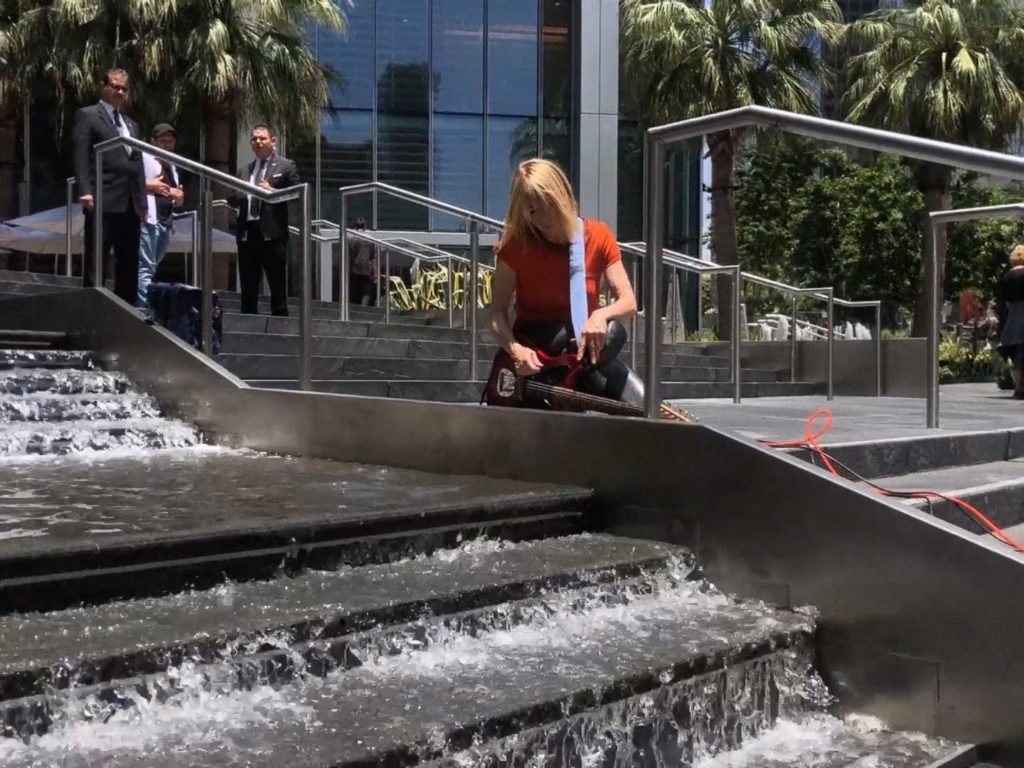
Kim Gordon, Los Angeles June 6, 2019 (2019), still. © Kim Gordon. Courtesy 303 Gallery, New York.
Even though the piece isn’t explicitly about L.A., the subtext is there—you’re engaging with the bones of the city itself. You spent decades on the East Coast before moving back to LA in 2016. Since then, what influence has the city had on your work?
I don’t know if LA has really influenced my work. I kind of feel like I always carried a bit of LA with me in New York. I don’t think it really changed in that way. I always liked the architecture, the weird customized houses, how you can have a tutor house next to a ranch. LA is a melting pot anyway. People move here from all over and the architecture reflects that. I also find it interesting how customizing one’s house or car is kind of the ultimate freedom of expression for people here. It’s always been my favorite city to look at. There’s so much space and distance; it’s very voyeuristic. But I think LA influenced my record more than my art.
Your history with art is longer than your history with music. Do you feel more comfortable in the art world than you do the music world?
Yeah, I do actually. Like a lot of people, I just kind of fell into music as a way to escape the art world. It was the spirit of post-punk do it yourself. I didn’t have any training in music at all. But I did go to art school, and I grew up wanting to be an artist since I was five, as cliche as that sounds. That’s why I moved to New York.
I don’t really think about the music world at all today. I’ve had to recently because I did the solo record, but I still don’t interact that much with the music scene in LA.
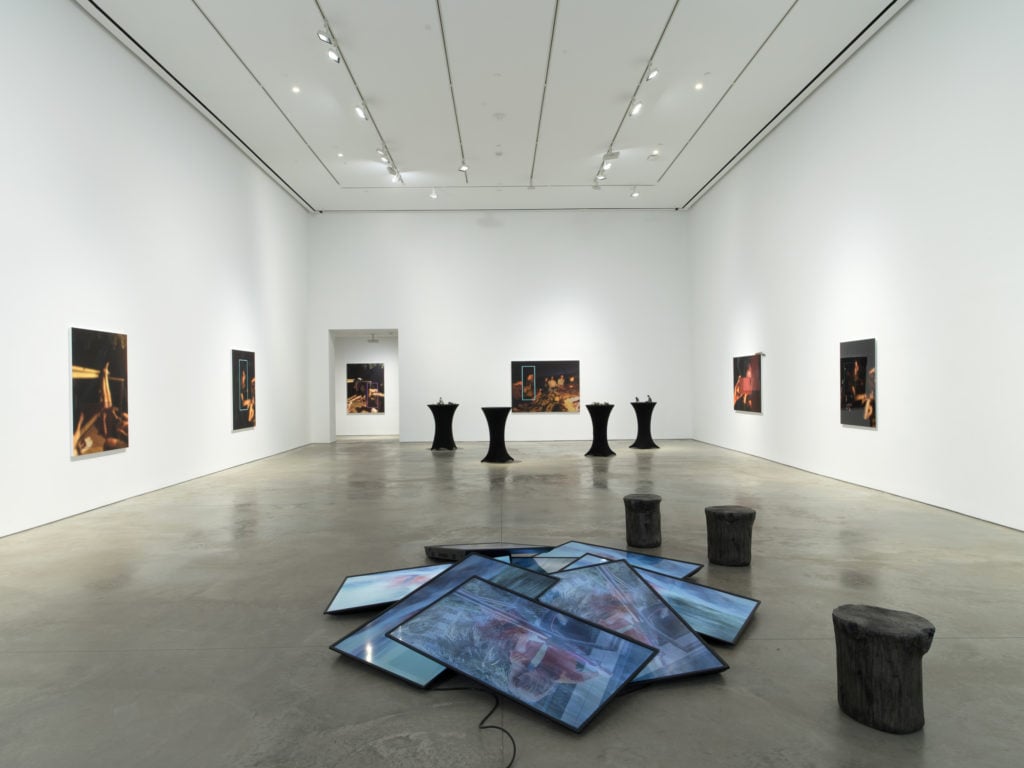
Installation view of “Kim Gordon: The Bonfire,” 303 Gallery, New York. Photo: John Berens. Courtesy of 303 Gallery.
When doing research for this interview, I found that most of the pieces of writing that were ostensibly about your art tended to focus more on your fashion and your time in bands. Rarely did they address your artwork critically. Do you find that people have a hard time separating, say, Sonic Youth Kim Gordon from artist Kim Gordon, or past Kim from present Kim?
Oh yeah, totally. It’s just something I feel like I always have to overcome. I should probably have more fun with it. [Laughs] I do feel like a lot of the pieces have been like the kind of journalism you often get in the music world, where it’s clear the writer just read the press release or something. But I haven’t had a straightforward, conventional art career. You have to really dig around to actually know what my work is. It’s kind of a drag. I think it’s just something I have to work out for myself. I don’t want to worry about what other people are thinking.
Your work is also quite disparate. Your word and wreath paintings, your sound and performance pieces, your abstract and figurative sculptures—if these were all to share the same room, unknowing visitors would conceivably be surprised to realize they were done by one person. Do you feel the same way?
For me it all goes back to design. When I did the survey show at White Columns in 2013, I brought it all together under the title “Design Office With Kim Gordon” and I was actually surprised at just how clearly you could really see a thread running through the whole thing. It was a lot of lo-fi design.
In the early ’80s, when I started Design Office, the idea was to do interventions in people’s apartments that were part psychological—I would take something personal about them and turn it into an art object, then physically alter the space in some way and write about it all in a magazine. I did a few of those. And if you look at the materials in the rest of my work since, the logic behind it, you can see those roots in some way. I’m still interested in interiors and I’ve always been influenced by how art and design interacts. It’s all somewhat performative.
Maybe I’m more of a sociologist. Think of me as a sociologist and it all makes more sense. [Laughs]
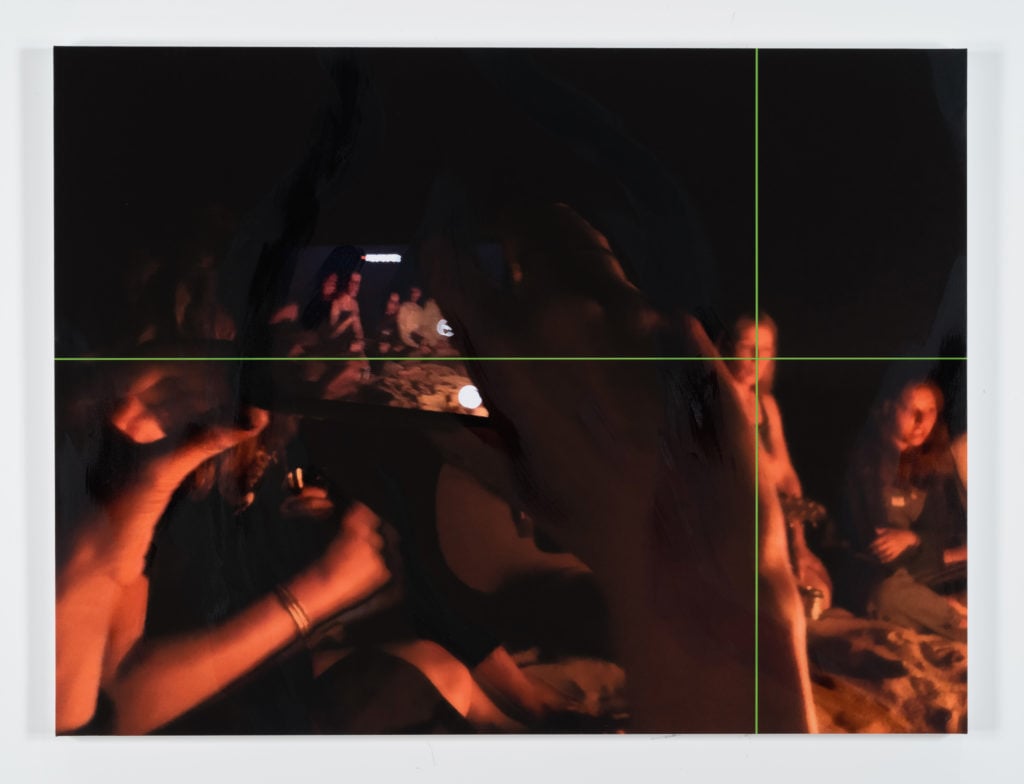
Kim Gordon, The Bonfire 10 (2019). © Kim Gordon. Courtesy 303 Gallery, New York.
You’ve spoken about the stranglehold the market has over the art world. Is this something you contend with in your own work or do you make things with the understanding that you can’t control their life after they leave the studio?
It’s definitely something I contend with, especially with installations. There’s something about professionalism in art that I just want to resist. It’s hard to make art that’s awkward anymore, or to make something that’s unexpected or surprising or unsettling in a way that’s not like blatantly offensive or sexual or cheap, especially in spaces like commercial galleries which are just white boxes.
“Kim Gordon: The Bonfire” is on view through February 22, 2020 at 303 Gallery.